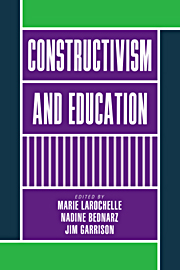Book contents
- Frontmatter
- Contents
- Preface
- List of contributors
- I Introduction
- II From epistemological constructivism to teaching: a variety of views
- III Teaching within the constructivist mode: practices and promises
- 5 Individual construction, mathematical acculturation, and the classroom community
- 6 The construction of answers to insoluble problems
- 7 Voice and perspective: hearing epistemological innovation in students' words
- 8 Constructivism-in-action: students examine their idea of science
- 9 Constructivism and ethical justification
- 10 Social studies, trivial constructivism, and the politics of social knowledge
- 11 Practical knowledge and school knowledge: a constructivist representation of education
- IV The mediating role of teachers and teacher education
- V Conclusion
- Notes
- References
- Index
5 - Individual construction, mathematical acculturation, and the classroom community
Published online by Cambridge University Press: 04 August 2010
- Frontmatter
- Contents
- Preface
- List of contributors
- I Introduction
- II From epistemological constructivism to teaching: a variety of views
- III Teaching within the constructivist mode: practices and promises
- 5 Individual construction, mathematical acculturation, and the classroom community
- 6 The construction of answers to insoluble problems
- 7 Voice and perspective: hearing epistemological innovation in students' words
- 8 Constructivism-in-action: students examine their idea of science
- 9 Constructivism and ethical justification
- 10 Social studies, trivial constructivism, and the politics of social knowledge
- 11 Practical knowledge and school knowledge: a constructivist representation of education
- IV The mediating role of teachers and teacher education
- V Conclusion
- Notes
- References
- Index
Summary
For the past six years we, together with Erna Yackel and Terry Wood, have conducted a classroom-based research and development project in elementary school mathematics. In this paper, we draw on our experiences of collaborating with teachers and of analyzing what might be happening in their classrooms to consider three interrelated issues. First, we argue that the teacher and students together create a classroom mathematics tradition or microculture and that this profoundly influences students’ mathematical activity and learning. Sample episodes are used to clarify the distinction between the school mathematics tradition in which the teacher acts as the sole mathematical authority and the inquiry mathematics tradition in which the teacher and students together constitute a community of validators. Second, we consider the theoretical and pragmatic tensions inherent in the view that mathematical learning is both a process of individual cognitive construction and a process of acculturation into the mathematical practices of wider society. In the course of the discussion, we contrast constructivist attempts to cope with this tension with approaches proposed by sociocultural theorists. Finally, we use the preceding issues as a backdrop against which to consider the development of instructional activities that might be appropriate for inquiry mathematics classrooms.
Classroom mathematics traditions
In the course of our work, we have conducted a series of second- and third-grade teaching experiments with seven- and eight-year-old students at both a rural/suburban site and an urban site that serves an almost exclusively African-American student population.
- Type
- Chapter
- Information
- Constructivism and Education , pp. 63 - 80Publisher: Cambridge University PressPrint publication year: 1998
- 8
- Cited by



